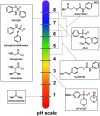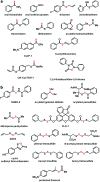Activatable Small-Molecule Hydrogen Sulfide Donors
- PMID: 31554416
- PMCID: PMC6918874
- DOI: 10.1089/ars.2019.7841
Activatable Small-Molecule Hydrogen Sulfide Donors
Abstract
Significance: Hydrogen sulfide (H2S) is an important biological signaling molecule involved in many physiological processes. These diverse roles have led researchers to develop contemporary methods to deliver H2S under physiologically relevant conditions and in response to various stimuli. Recent Advances: Different small-molecule donors have been developed that release H2S under various conditions. Key examples include donors activated in response to hydrolysis, to endogenous species, such as thiols, reactive oxygen species, and enzymes, and to external stimuli, such as photoactivation and bio-orthogonal chemistry. In addition, an alternative approach to release H2S has utilized the catalyzed hydrolysis of carbonyl sulfide (COS) by carbonic anhydrase to generate libraries of activatable COS-based H2S donors. Critical Issues: Small-molecule H2S donors provide important research and pharmacological tools to perturb H2S levels. Key needs, both in the development and in the use of such donors, include access to new donors that respond to specific stimuli as well as donors with well-defined control compounds that allow for clear delineation of the impact of H2S delivery from other donor byproducts. Future Directions: The abundance of reported small-molecule H2S donors provides biologists and physiologists with a chemical toolbox to ask key biological questions and to develop H2S-related therapeutic interventions. Further investigation into different releasing efficiencies in biological contexts and a clear understanding of biological responses to donors that release H2S gradually (e.g., hours to days) versus donors that generate H2S quickly (e.g., seconds to minutes) is needed.
Keywords: carbonyl sulfide; hydrogen sulfide; reactive sulfur species; small molecule donors.
Conflict of interest statement
No financial conflicts of interest are reported.
Figures








References
-
- Alshorafa AKH, Guo Q, Zeng FQ, Chen MC, Tan GZ, Tang ZQ, and Yin RF. Psoriasis is associated with low serum levels of hydrogen sulfide, a potential anti-inflammatory molecule. Tohuku J Exp Med 228: 325–332, 2012 - PubMed
-
- Barresi E, Nesi G, Citi V, Piragine E, Piano I, Taliani S, Da Settimo F, Rapposelli S, Testai L, Breschi MC, Gargini C, Calderone V, and Martelli A. Iminothioethers as hydrogen sulfide donors: from the gasotransmitter release to the vascular effects. J Med Chem 60: 7512–7523, 2017 - PubMed
Publication types
MeSH terms
Substances
Grants and funding
LinkOut - more resources
Full Text Sources

